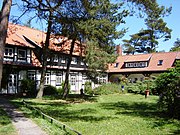Zingsthof
The Zingsthof is a church recreation and Rüstzeitheim in Seeheilbad Zingst on the eponymous peninsula on the Baltic Sea .
history
The Zingsthof was founded in 1929 as the home of the Westphalian Biblical Circle . The buildings were built in 1929 according to the design by the architect Herbert Engelke on a pasture area purchased for this purpose about one kilometer east of Zingst. The first manager of the Zingsthof, Siegwald Pentz, soon expanded the premises with several outbuildings. After the inauguration on August 18, 1929, the Zingsthof was used for work and as a recreational opportunity for the Westphalian student Bible groups.
In spring 1935, the theologian and resistance fighter against the Nazi regime chose Dietrich Bonhoeffer the Zingsthof as accommodation for the by him on behalf of the Confessing Church -run seminary from. Bonhoeffer and the seminarians lived at the Zingsthof in May and June, after which the seminar was relocated to Finkenwalde in Western Pomerania . On June 2, 1935, Bonhoeffer held a service in the Zingster Peter-Pauls Church and attracted a great deal of attention through intercession for imprisoned pastors of the Confessing Church. Although the seminar had to work illegally after the ban by the National Socialists, Bonhoeffer succeeded again in June 1938 in gathering all available seminarians for a few days at the Zingsthof.
The Zingsthof suffered considerable hindrances from the state authorities during the National Socialist era . Home manager Pentz was arrested at short notice and then banished from Zingst with his family. As a precaution, the Zingsthof was sold in 1939 to the Protestant church district of Barth, in whose area the facility was located. During this time, the church district ensured the home was better protected.
After the emergence of the GDR, the Zingsthof remained in the possession of the Barth parish of the Pomeranian Evangelical Church and was used for children's recovery cures and preparation times for church youth groups. The GDR authorities tried to prevent church child and youth work on the Zingsthof - the closure was threatened several times due to alleged hygienic abuses, but the Pomeranian church leadership was able to reject these attacks. From 1971 to 2007 the Zingsthof was managed by Eckhard Lipke. During the GDR era, the Zingsthof received special support from parishes of the North Elbe Church in West Germany.
After the political change in 1989, the Pomeranian Diakonie took over the Zingsthof by 2007 , which was still used as a church rest and rehabilitation home. It was extensively renovated in the 1990s and expanded to include several guest houses and later the “Bonhoeffer Chapel”. In the chapel there is a memorial plaque by the sculptor Doris Oberländer from the early 1960s, which reminds of Bonhoeffer's work at the Zingsthof.
As a result of financial difficulties of the Pomeranian Diakonie, the Zingsthof had to be sold in 2007, it is now owned by the Berlin City Mission . The focus on church recreational offers, especially for families with many children, remains. In addition, the Zingsthof is the meeting place for various church groups from across the EKD .
literature
- Albrecht Schönherr : He did what he believed, thought and wanted - Dietrich Bonhoeffer . In: Berlin monthly magazine ( Luisenstädtischer Bildungsverein ) . Issue 2, 1999, ISSN 0944-5560 ( luise-berlin.de ).
Web links
- Literature about Zingsthof in the state bibliography MV
- official website
- Church Zingst at ev-kirche-zingst.de
Individual evidence
Coordinates: 54 ° 26 '24 " N , 12 ° 43' 17" E


